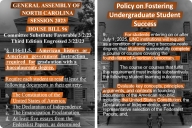You have /5 articles left.
Sign up for a free account or log in.
To the Editor:
Workforce shortages and growing student interest in high-demand fields present a chance for our higher education system to scale programs and reimagine pathways that lead to economic mobility. But it’s frustrating to see that when our colleges and universities are afforded the chance to diverge from the norm, they often don't.
As Johanna Alonso recently reported in her article, "Universities Can’t Accommodate All the Computer Science Majors" (Nov. 2), institutions across the country are facing a conundrum. STEM degrees are rapidly growing in popularity due to the perception that they’ll lead to better job outcomes with higher pay, but universities can’t keep up with demand.
It’s not from a lack of trying or a lack of care; in fact, one faculty member is quoted as saying they’ve done “everything” to scale up their classes, and that faculty across the board feel strongly about meeting the demand. Yet “everything” is really just code for “more of the same”: hiring more faculty and building new facilities to reduce ballooning class sizes. Measures like these can help, but they’re not a sustainable solution for achieving scale. Instead, they’re yet another example of higher ed’s tendency to over-index on what we already know how to do, rather than exploring new, innovative models that could benefit students, institutions, and the workforce.
Case in point: despite online learning likely being our greatest tool for dramatically scaling programs at a fraction of the cost, those cited in the article did not reference it once as a solution, and it’s not because some of the universities mentioned in the article haven’t yet dipped their toes into the world of tech-enabled learning. Today, both innovative online universities and established brick-and-mortar institutions are leveraging online learning to provide students with greater flexibility and personal ownership over their experience; recently it was reported that 70 percent of college students are enrolled in at least one online course.
But offering online courses or even programs doesn’t necessarily mean an institution is fully capitalizing on technology’s potential to significantly expand access to education and address workforce needs. As with any innovation, its potential rests in how it’s deployed. Unfortunately, promising innovations like online learning are often deployed with the same artificial constraints that exist in traditional models of learning, for instance faculty teaching loads, synchronous virtual lectures, and fixed-pace schedules.
The good news is higher ed can reimagine learning to address the growing interest for in-demand degrees like computer science and cybersecurity, and help hundreds of thousands of students improve their lives and those of their families. But to realize this promise, they’ll need to think more expansively than many do today, free themselves from conventional notions of what learning looks like, and address demand problem by solving from the ground up. While approaches will vary, reimagining the following traditional constraints can be a start:
- Perceptions of quality: Small classes, impressive facilities, distinguished faculty, and other such criteria are often considered hallmarks of quality. But strong, equitable learning outcomes and program relevancy to the world of work are what really count.
- Barriers of time and place: Innovations like online learning can be a powerful tool for reaching more learners, but to capitalize on its potential students should be enabled to learn whenever and wherever it best suits them. Unfortunately, some institutions still require faculty to deliver online lectures at specific times, akin to forcing Netflix users to log in at a set time each week to catch the latest episode of their favorite series.
- Traditional faculty role: Often when institutions embrace new models of learning, they retain the conventional role of faculty members. A single faculty member can only accomplish so much, yet they may be required to develop the syllabus, deliver a virtual lecture multiple times a week, grade papers, and design assessments. Deploying faculty in this way impedes innovations with the potential to expand capacity to enroll, teach, and graduate more students. In contrast, addressing volume from the start might result in removing the “lecture” format of content delivery to allow students to consume rich digital content on their own time and in their own way, with credentialed instructors available to offer one-on-one teaching as needed. It might also mean rethinking office hours and replacing them with peer-to-peer mentor communities, and leveraging AI to identify when students are struggling.
I have no doubt that the individuals and institutions cited in Alonso’s article are motivated to put more individuals on a pathway that can lead to economic mobility and security. But even if a forward-thinking president advocated for removing some of the constraints mentioned, they’d likely experience significant resistance due to structural challenges, restrictive policies, and traditional mindsets. Wide-sweeping changes require a new way of thinking and understanding of education’s primary purpose: connecting individuals to opportunity.
As more organizations digitize their operations, we can expect to see a greater need for highly skilled workers. The U.S. Bureau of Labor and Statistics, for instance, projects a 23% increase in computing job demand this year, but Brookings reports that the US is not producing enough individuals skilled in STEM competencies. Unable to keep pace with growing demand, if colleges and universities continue to do more of the same, they’ll have no choice but to turn away students who are eager to learn. We have a chance to break from convention; let’s not waste it.
--Scott Pulsipher
President
Western Governors University





